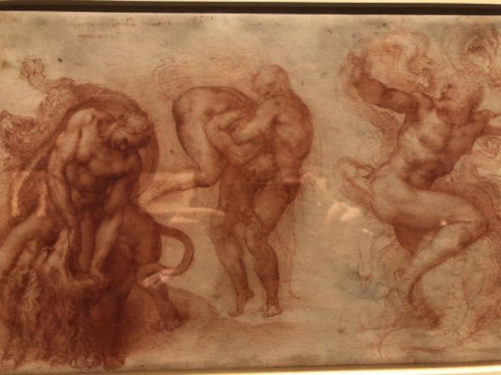Vast Exhibit of Drawings Runs Through Feb. 12
By Christopher White, National Correspondent

Finished works by the great Michelangelo Buonarroti – the Sistine Chapel, the Pietà, the statue of David – continue to captivate millions of viewers each year. But before the Renaissance genius picked up his brush or chisel, he began with chalk to sketch what would become some of the world’s most enduring art masterpieces.
Now, these drawings are on full view in a momentous new exhibition at The Metropolitan Museum of Art.
“Michelangelo: Divine Draftsman & Designer” runs through Feb. 12 and may be the most comprehensive collection of the artist’s work to be on display this side of Europe for many decades to come.
The Divine One
Born in Florence in 1475, Michelangelo would create some of his masterpieces before even turning 30 years old. His contemporaries labeled him Il Divino (“The Divine One”), and he was widely lauded for his unrivaled disegno – both the actual technique of his drawing, and the innovative theories motivating it.
More than 130 of his drawings are on full display in this Met exhibition, along with three sculptures and a handful of his paintings, including his earliest known one, “The Torment of Saint Anthony,” on loan from the Kimbell Art Museum.
Of particular interest in this exhibit are Michelangelo’s early drawings, as one can view the master learning to perfect the human form. These drawings are impressive by any measure, but when reflecting on the craftsmanship needed to transform a sketch of paper into a stone sculpture, it’s apparent why he continues to inspire 500 years later.
Also on display is an early study of the famed “The Creation of Adam,” from the Genesis narrative on the Sistine ceiling. This scene is one of the most replicated pieces of art of all time, and seeing it in its most nascent form is a testament to the act of creation itself, both in style and subject.
While the simple red- and black-chalk sketches may stand in contrast to the stunning colors that define Michelangelo’s frescoes, they are a testament to the technique that fast-tracked his success and made him a resident artist to popes and princes.
Henry Bleattler, chair of the Media, Culture and Arts program at The King’s College in New York, praised the exhibit for introducing Michelangelo to a new generation.
“I tell my students that the foundation of all praiseworthy visual art is the ability to draw from nature, from life.
“The Met’s presentation of over a hundred of Michelangelo’s drawings is a master class in the discipline of this kind of study and that even so great an artist as he had to start with the basics. That’s a pretty timeless lesson for all of us but a particularly essential one for my students to grasp early in life,” Bleattler said.
Earlier this year, another Michelangelo-inspired exhibit opened inside the Oculus, a transportation hub at the World Trade Center in New York. The exhibit, “Up Close: Michelangelo’s Sistine Chapel,” reproduced 34 frescoes from the chapel in their original sizes where viewers could have access to them in a way that would otherwise be impossible.
Two weeks ago, a rediscovered painting by Leonardo da Vinci sold for just over $450 million at a New York auction. Earlier in the month, the Metropolitan Museum of Art announced that its costume institute’s spring show would be themed “Heavenly Bodies: Fashion and the Catholic Imagination,” prompting some to wonder whether Catholic-inspired art is making a comeback.
Old World ‘Isn’t Obsolete’
“In an age where Western culture is often scorned and increasingly jettisoned from the curriculum of ‘good education,’ the spectacular sale of a Leonardo da Vinci painting showing Christ the Savior and the blockbuster exhibition on Michelangelo at the Met suggest that the Old World isn’t obsolete yet,” said Rome-based art historian Elizabeth Lev.
Lev told The Tablet this trend in the art world is a sign of the Church’s enduring relevance, even if unconventional to some.
“These artists, despite being white men in the employ of ‘patriarchal’ institutions, created images that are universally fascinating, even in this age of diversity. Leonardo’s technical prowess and Michelangelo’s virtuoso expressions of the human form invite people to imagine the best versions of themselves and their society, something the world needs more than ever,” Lev said.
“Perhaps the universal Church still has something to teach in the age of globalization,” she added.
Michelangelo was known during his time as a perfectionist, so much so that the very thought of his drawings being viewed by anyone was a wound to his pride.
Throughout his career, Michelangelo frequently destroyed them and requested that after his death in 1564 that the remnant of his practice sketches be burned, so that, according to the Renaissance art historian Giorgio Vasari, “no one might see the labors he endured and the methods with which he tested his imagination, so that he might appear nothing less than perfect.”
These labors – while imperfect by Michelangelo’s standards, but undeniably inspired – are a treasure for both the Church and the world and The Metropolitan Museum of Art has done both a great service by chronicling them anew.
Editor’s note: For more on the exhibit, visit www.metmuseum.org.
